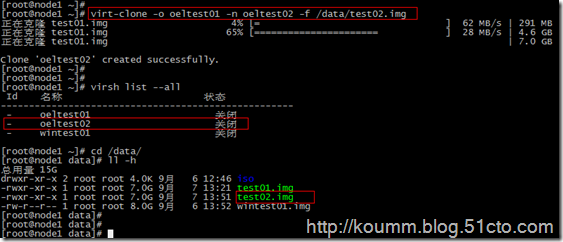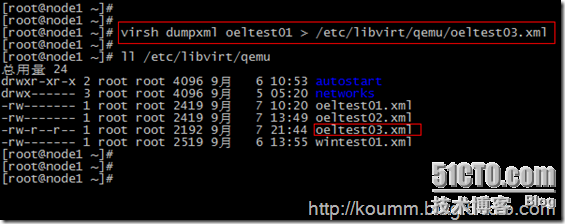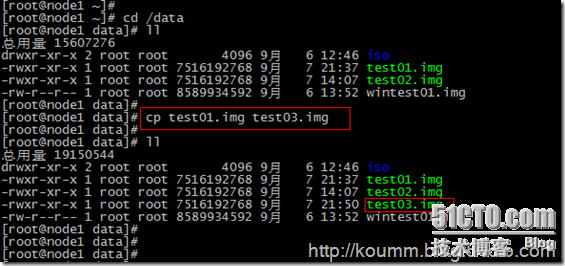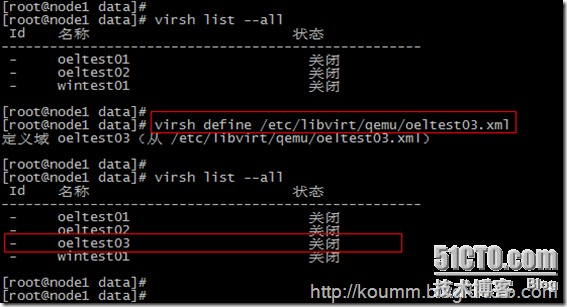kvm虚拟化之kvm虚拟机克隆
kvm虚拟机的克隆分为两种情况,本文也就通过以下两种情况进行克隆,克隆虚拟机为OEL5.8X64。
(1) KVM主机本机虚拟机直接克隆。
(2) 通过复制配置文件与磁盘文件的虚拟机复制克隆(适用于异机的静态迁移)。
1. 本机虚拟机直接克隆
(1) 查看虚拟机配置文件
- [root@node1 ~]# cat /etc/libvirt/qemu/oeltest01.xml
- <!--
- WARNING: THIS IS AN AUTO-GENERATED FILE. CHANGES TO IT ARE LIKELY TO BE
- OVERWRITTEN AND LOST. Changes to this xml configuration should be made using:
- virsh edit oeltest01
- or other application using the libvirt API.
- -->
- <domain type='kvm'>
- <name>oeltest01</name>
- <uuid>8f2bb4a7-c7ed-32aa--9fb05923269d</uuid>
- <memory unit='KiB'></memory>
- <currentMemory unit='KiB'></currentMemory>
- <vcpu placement='static'></vcpu>
- <os>
- <type arch='x86_64' machine='rhel6.4.0'>hvm</type>
- <boot dev='hd'/>
- </os>
- <features>
- <acpi/>
- <apic/>
- <pae/>
- </features>
- <clock offset='utc'/>
- <on_poweroff>destroy</on_poweroff>
- <on_reboot>restart</on_reboot>
- <on_crash>restart</on_crash>
- <devices>
- <emulator>/usr/libexec/qemu-kvm</emulator>
- <disk type='file' device='disk'>
- <driver name='qemu' type='raw' cache='none'/>
- <source file='/data/test01.img'/>
- <target dev='hda' bus='ide'/>
- <address type='drive' controller='' bus='' target='' unit=''/>
- </disk>
- <disk type='block' device='cdrom'>
- <driver name='qemu' type='raw'/>
- <target dev='hdc' bus='ide'/>
- <readonly/>
- <address type='drive' controller='' bus='' target='' unit=''/>
- </disk>
- <controller type='usb' index=''>
- <address type='pci' domain='0x0000' bus='0x00' slot='0x01' function='0x2'/>
- </controller>
- <controller type='ide' index=''>
- <address type='pci' domain='0x0000' bus='0x00' slot='0x01' function='0x1'/>
- </controller>
- <interface type='bridge'>
- <mac address='52:54:00:82:39:01'/>
- <source bridge='br0'/>
- <model type='virtio'/>
- <address type='pci' domain='0x0000' bus='0x00' slot='0x03' function='0x0'/>
- </interface>
- <serial type='pty'>
- <target port=''/>
- </serial>
- <console type='pty'>
- <target type='serial' port=''/>
- </console>
- <input type='tablet' bus='usb'/>
- <input type='mouse' bus='ps2'/>
- <graphics type='vnc' port='' autoport='no' listen='0.0.0.0'>
- <listen type='address' address='0.0.0.0'/>
- </graphics>
- <video>
- <model type='cirrus' vram='' heads=''/>
- <address type='pci' domain='0x0000' bus='0x00' slot='0x02' function='0x0'/>
- </video>
- <memballoon model='virtio'>
- <address type='pci' domain='0x0000' bus='0x00' slot='0x04' function='0x0'/>
- </memballoon>
- </devices>
- </domain>
虚拟机磁盘文件: /data/test01.img
虚拟机名称:oeltest01

(2) 开始克隆
- # virt-clone -o oeltest01 -n oeltest02 -f /data/test02.img
说明:以oeltest01做为源,克隆oeltest01虚拟机,并创建名称为oeltest02虚拟机,使用磁盘文件/data/test02.img

(3) 启动虚拟机并配置主机名,IP地址等

[root@node1 data]# virsh console oeltest02
- 连接到域 oeltest02
- Escape character is ^]
- Found volume group "vg" using metadata type lvm2
- logical volume(s) in volume group "vg" now active
- Welcome to Oracle Linux Oracle Linux Server release 5.8
- Press 'I' to enter interactive startup.
- Starting udev: [ OK ]
- Loading default keymap (us): [ OK ]
- Setting hostname test01: [ OK ]
- Setting up Logical Volume Management: logical volume(s) in volume group "vg" now active
- [ OK ]
- Checking filesystems
- Checking all file systems.
- [/sbin/fsck.ext3 () -- /] fsck.ext3 -a /dev/vg/root
- /dev/vg/root: clean, / files, / blocks
- [/sbin/fsck.ext3 () -- /boot] fsck.ext3 -a /dev/hda1
- /boot: clean, / files, / blocks
- [ OK ]
- Remounting root filesystem in read-write mode: [ OK ]
- Mounting local filesystems: [ OK ]
- Enabling local filesystem quotas: [ OK ]
- Enabling /etc/fstab swaps: [ OK ]
- INIT: Entering runlevel:
- Entering non-interactive startup
- Applying Intel CPU microcode update: [ OK ]
- Starting background readahead: [ OK ]
- Checking for hardware changes [ OK ]
- [ OK ] iSCSI daemon: [ OK ]
- [ OK ]
- Bringing up loopback interface: [ OK ]
- Bringing up interface eth0:
- Determining IP information for eth0... done.
- [ OK ]
- Starting auditd: [ OK ]
- Starting system logger: [ OK ]
- Starting kernel logger: [ OK ]
- Starting irqbalance: [ OK ]
- iscsid (pid ) is running...
- Setting up iSCSI targets: iscsiadm: No records found
- [ OK ]
- Starting portmap: [ OK ]
- Starting NFS statd: [ OK ]
- Starting RPC idmapd: [ OK ]
- Starting system message bus: [ OK ]
- Starting o2cb: [ OK ]
- [ OK ] Bluetooth services:[ OK ]
- Mounting other filesystems: [ OK ]
- Starting PC/SC smart card daemon (pcscd): [ OK ]
- Starting acpi daemon: [ OK ]
- Starting HAL daemon: [ OK ]
- Starting hidd: [ OK ]
- Starting monitoring for VG vg: logical volume(s) in volume group "vg" monitored
- [ OK ]
- Starting autofs: Loading autofs4: [ OK ]
- Starting automount: [ OK ]
- [ OK ]
- Starting hpiod: [ OK ]
- Starting hpssd: [ OK ]
- Starting sshd: [ OK ]
- Starting cups: [ OK ]
- Starting xinetd: [ OK ]
- Starting console mouse services: [ OK ]
- Starting crond: [ OK ]
- Starting xfs: [ OK ]
- Starting anacron: [ OK ]
- [ OK ] atd: [ OK ]
- Starting background readahead: [ OK ]
- Starting yum-updatesd: [ OK ]
- Starting Avahi daemon... [ OK ]
- Starting smartd: hdc: drive_cmd: status=0x41 { DriveReady Error }
- hdc: drive_cmd: error=0x04 { AbortedCommand }
- ide: failed opcode was: 0xec
- [ OK ]
- Oracle Linux Server release 5.8
- Kernel 2.6.-.el5 on an x86_64
- test01 login: mtrr: type mismatch for f0000000, old: uncachable new: write-combining
- mtrr: type mismatch for f0000000, old: uncachable new: write-combining
- Oracle Linux Server release 5.8
- Kernel 2.6.-.el5 on an x86_64
- test01 login:
- Oracle Linux Server release 5.8
- Kernel 2.6.-.el5 on an x86_64
- test01 login: root
- Password:
- Last login: Sat Sep :: on ttyS0
- [root@test01 ~]#
- [root@test01 ~]#
- [root@test01 ~]#
- () 修改主机名,IP地址等
- # vi /etc/hosts
- # Do not remove the following line, or various programs
- # that require network functionality will fail.
- 127.0.0.1 test02 localhost.localdomain localhost
- :: localhost6.localdomain6 localhost6
- # vi /etc/sysconfig/network
- NETWORKING=yes
- NETWORKING_IPV6=no
- HOSTNAME=test02
- GATEWAY=192.168.233.2
- 修改IP地址
- # vi /etc/sysconfig/network-script/ifcfg-eth0
- # Virtio Network Device
- DEVICE=eth0
- BOOTPROTO=static
- ONBOOT=yes
- HWADDR=::::bd:2b
- IPADDR=192.168.233.142
- NETMASK=255.255.255.0
- [root@test01 ~]# service network restart
- Shutting down interface eth0: [ OK ]
- Shutting down loopback interface: [ OK ]
- Bringing up loopback interface: [ OK ]
- Bringing up interface eth0: [ OK ]
- [root@test01 ~]#
2. 复制配置文件与磁盘文件克隆
(1) 导入kvm虚拟机配置文件
这里采用oeltest01做为模板,进行克隆。
- # virsh shutdown oeltest01

- # virsh dumpxml oeltest01 > /etc/libvirt/qemu/oeltest03.xml

(2) 复制kvm虚拟机磁盘文件
本系列文章都是采用虚拟磁盘文件进行测试,没有使用lvm卷。
通过查看配置文件:虚拟磁盘位置<source file='/data/test01.img'/>

(3) 直接编辑修改配置文件
修改name,uuid,disk位置,vnc端口
此时还是将该配置文件注册进来,无法通过virsh edit进行编辑。
- [root@node1 data]# vi /etc/libvirt/qemu/oeltest03.xml
- <domain type='kvm'>
- <name>oeltest03</name>
- <uuid>8f2bb4a7-c7ed-32aa--9fb05923260d</uuid>
- <memory unit='KiB'></memory>
- <currentMemory unit='KiB'></currentMemory>
- <vcpu placement='static'></vcpu>
- <os>
- <type arch='x86_64' machine='rhel6.4.0'>hvm</type>
- <boot dev='hd'/>
- </os>
- <features>
- <acpi/>
- <apic/>
- <pae/>
- </features>
- <clock offset='utc'/>
- <on_poweroff>destroy</on_poweroff>
- <on_reboot>restart</on_reboot>
- <on_crash>restart</on_crash>
- <devices>
- <emulator>/usr/libexec/qemu-kvm</emulator>
- <disk type='file' device='disk'>
- <driver name='qemu' type='raw' cache='none'/>
- <source file='/data/test03.img'/>
- <target dev='hda' bus='ide'/>
- <address type='drive' controller='' bus='' target='' unit=''/>
- </disk>
- <disk type='block' device='cdrom'>
- <driver name='qemu' type='raw'/>
- <target dev='hdc' bus='ide'/>
- <readonly/>
- <address type='drive' controller='' bus='' target='' unit=''/>
- </disk>
- <controller type='usb' index=''>
- <address type='pci' domain='0x0000' bus='0x00' slot='0x01' function='0x2'/>
- </controller>
- <controller type='ide' index=''>
- <address type='pci' domain='0x0000' bus='0x00' slot='0x01' function='0x1'/>
- </controller>
- <interface type='bridge'>
- <mac address='52:54:00:82:39:01'/>
- <source bridge='br0'/>
- <model type='virtio'/>
- <address type='pci' domain='0x0000' bus='0x00' slot='0x03' function='0x0'/>
- </interface>
- <serial type='pty'>
- <target port=''/>
- </serial>
- <console type='pty'>
- <target type='serial' port=''/>
- </console>
- <input type='tablet' bus='usb'/>
- <input type='mouse' bus='ps2'/>
- <graphics type='vnc' port='' autoport='no' listen='0.0.0.0'>
- <listen type='address' address='0.0.0.0'/>
- </graphics>
- <video>
- <model type='cirrus' vram='' heads=''/>
- <address type='pci' domain='0x0000' bus='0x00' slot='0x02' function='0x0'/>
- </video>
- <memballoon model='virtio'>
- <address type='pci' domain='0x0000' bus='0x00' slot='0x04' function='0x0'/>
- </memballoon>
- </devices>
- </domain>
(4) 定义新虚拟机配置文件
- [root@node1 data]# virsh define /etc/libvirt/qemu/oeltest03.xml

启动虚拟机
- [root@node1 data]# virsh start oeltest03
- 域 oeltest03 已开始
(5) 登录虚拟机进行主机名,IP等修改
- [root@node1 data]# virsh console oeltest03
- 连接到域 oeltest03
- Escape character is ^]
- Oracle Linux Server release 5.8
- Kernel 2.6.-.el5 on an x86_64
- test01 login: mtrr: type mismatch for f0000000, old: uncachable new: write-combining
- mtrr: type mismatch for f0000000, old: uncachable new: write-combining
- Oracle Linux Server release 5.8
- Kernel 2.6.-.el5 on an x86_64
- test01 login: root
- Password:
- Last login: Sat Sep :: on ttyS0
- [root@test01 ~]#
- [root@test01 ~]#
- 修改主机名
- # vi /etc/hosts
- # Do not remove the following line, or various programs
- # that require network functionality will fail.
- 127.0.0.1 test03 localhost.localdomain localhost
- :: localhost6.localdomain6 localhost6
- # vi /etc/sysconfig/network
- NETWORKING=yes
- NETWORKING_IPV6=no
- HOSTNAME=test03
- GATEWAY=192.168.233.2
- 修改IP地址
- # vi /etc/sysconfig/network-script/ifcfg-eth0
- # Virtio Network Device
- DEVICE=eth0
- BOOTPROTO=static
- ONBOOT=yes
- HWADDR=::::bd:3b
- IPADDR=192.168.233.143
- NETMASK=255.255.255.0
- service network restart
- Shutting down interface eth0: [ OK ]
- Shutting down loopback interface: [ OK ]
- Bringing up loopback interface: [ OK ]
- Bringing up interface eth0: [ OK ]
本文到此通过两种方式进行kvm虚拟机克隆,其实各有用处。
再次说明:本文克隆的虚拟机是oel5.8,如果克隆的虚拟机是RHEL/CentOS/OEL6.x操作系统,还需要修改/etc/udev/rules.d/70-persistent-net.rules文件。
kvm虚拟化之kvm虚拟机克隆的更多相关文章
- kvm虚拟化之kvm虚拟机快照备份
kvm虚拟机默认使用raw格式的镜像格式,性能最好,速度最快,它的缺点就是不支持一些新的功能,如支持镜像,zlib磁盘压缩,AES加密等. 要使用镜像功能,磁盘格式必须为qcow2.下面开始kvm ...
- kvm虚拟化之kvm虚拟机vnc配置
本文是通过vnc方式访问虚拟主机上的KVM虚拟机. 这里的通过vnc方式访问虚拟机不是在kvm虚拟机安装配置vnc服务器,通过虚拟主机的IP地址与端口进行访问,kvm虚拟化对vnc的支持相对来说 ...
- KVM虚拟化之windows虚拟机性能调整
通过KVM安装WindowsXP/2003/7/2008操作系统后,由于默认的磁盘驱动(IDE)性能与网卡驱动(RTL8139100M)的性能都极其低下,需要调整,通过加载Redhatvirtio驱动 ...
- kvm虚拟化安装及虚拟机创建
1.开启虚拟化(VMware虚拟机为例),安装centos7操作系统. 2.查看CPU是否开启虚拟化 #zgrep "vmx" /proc/cpuinfo 3.配置yum源,通过 ...
- KVM虚拟化(KVM简介和KVM安装)
KVM 虚拟化架构分类 寄居虚拟化架构:指在宿主操作系统之上安装和运行虚拟化程序,依赖于宿主操作系统对设备的支持和物理资源的管理. 裸金属虚拟化架构:指直接在硬件上面安装虚拟化软件,再在其上安装操作系 ...
- CentOS7.1 KVM虚拟化之linux虚拟机安装(2)
一.上传ISO文件到/data/iso下 这里使用CentOS-5.5-i386-bin-DVD.iso 二.安装CentOS5.5 CentOS7.1 安装KVM虚拟机默认磁盘格式为qcow2(推荐 ...
- Kvm虚拟化安装与虚拟机创建
1. 验证CPU是否支持KVM:如果结果中有vmx(Intel)或svm(AMD)字样,就说明CPU的支持的. egrep '(vmx|svm)' /proc/cpuinfo 2. 关闭SELinux ...
- kvm虚拟化之kvm虚拟机控制台登陆
vm虚拟机能否像xen虚拟机一样通过virsh console 一样采用字符界面进行linux虚拟机控制台呢,答案是肯定的,默认情况下该命令是不起作用的,需要修改相关文件才能实现. 1. 配置方法如下 ...
- kvm虚拟化学习笔记(三)之windows kvm虚拟机安装
KVM虚拟化学习笔记系列文章列表----------------------------------------kvm虚拟化学习笔记(一)之kvm虚拟化环境安装http://koumm.blog.51 ...
随机推荐
- Differences Between 3 Types Of Proxy Servers: Normal, Transparent And Reverse Proxy
What is a Proxy Server? A Proxy server is an intermediary machine, between a client and the actual s ...
- XPath在python中的高级应用
XPath在python的爬虫学习中,起着举足轻重的地位,对比正则表达式 re两者可以完成同样的工作,实现的功能也差不多,但XPath明显比re具有优势,在网页分析上使re退居二线. XPath介绍: ...
- Echarts主题颜色
Echarts主题颜色搜集: 直接覆盖默认颜色即可 例如在 echarts.setOption({ '#2ec7c9','#b6a2de','#5ab1ef','#ffb980','#d87a80', ...
- ubuntu如何安装samba
1.samba安装sudo apt-get install samba2.修改smb.confsudo gedit /etc/samba/smb.conf 文件最后增加如下代码:[share] pat ...
- 实践作业4:Web测试实践(小组作业)每日任务记录3
会议时间:2017年12月23日 会议地点:东九教学楼自习区 主 持 人:王晨懿 参会人员:王晨懿.余晨晨.郑锦波.杨潇.侯欢.汪元 记 录 人:王晨懿 会议议题:小组作业第二阶段 下面是今天 ...
- Auth模块
文本目录 1 扩展默认的auth_user表 2 auth模块是什么 3 auth模块的常用方法 1 扩展默认的auth_user 表 在开始写项目之前,我们要创建表,同事内置的认证系统又很好用,但是 ...
- C#通过Redis实现分布式锁
Redis有三个最基本属性来保证分布式锁的有效实现: 安全性: 互斥,在任何时候,只有一个客户端能持有锁. 活跃性A:没有死锁,即使客户端在持有锁的时候崩溃,最后也会有其他客户端能获得锁,超时机制. ...
- C#6.0特性(快来围观)(转)
出处:http://www.cnblogs.com/HJL-Blog/p/4457632.html 说明一下,很多博友一进来就认为仅仅是语法糖,C#语法的更新,代表着它的进步,语法糖是为了让我们更好的 ...
- 【转】彻底理解ThreadLocal
ThreadLocal是什么 早在JDK 1.2的版本中就提供Java.lang.ThreadLocal,ThreadLocal为解决多线程程序的并发问题提供了一种新的思路.使用这个工具类可以很简洁地 ...
- aspnetcore的那些actionresult们
比MVC5多了n个actionresult,傻傻分不清,整理了下,妈妈再也不用担心了 https://docs.asp.net/projects/api/en/latest/autoapi/Micro ...
